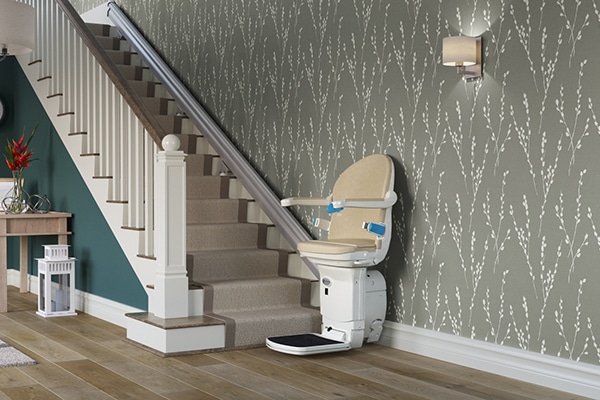- Widen the doorways and hallways.
- Modify the flooring.
- Rethink your furniture placement.
- Adapt the kitchen.
- Leverage smart home technology.
- Adjust light switches and outlets.
- Create accessible bathrooms.
- Install grab bars and handrails.
- Seek professional consultation.
- Install a wheelchair lift.
- Install a wheelchair ramp outside of your home.
Do you live with a loved one who uses a wheelchair for mobility? If so, you’ve undoubtedly had to make some significant changes to the makeup of your home. Naturally, it’s vital to make it a safe haven for all of its inhabitants. It is essential to ensure that every individual, regardless of mobility challenges, can navigate their living spaces with ease and dignity.
Your home, however, must be wheelchair accessible. The required changes to the domicile are significant steps towards creating an inclusive environment for family members, friends and visitors with mobility impairments. So what must be done to ensure you have an inclusive home?
Widen the doorways and hallways.
Standard doorways might not accommodate the width of a wheelchair. Of course, this makes movement throughout the home challenging. By widening these spaces, individuals using wheelchairs can navigate freely without constraints. A minimum doorway width of 32 inches is recommended. Hallways should be at least 36 inches wide to allow comfortable passage.
“While open-concept designs in newer homes can improve mobility in some spaces, widening door frames can still be an important modification,” writes Josh Skapin of the Calgary Real Estate Board, “Entrances should be 36 inches wide with a five-feet-by-five-feet area of free space both ahead of and behind the door to provide an effective turning cycle.”
Modify the flooring.
Choosing the right flooring and surfaces can significantly impact wheelchair accessibility. Smooth and even surfaces, such as hardwood or laminate flooring, allow for easy movement. Avoid thick carpets or rugs. They can create friction and make it difficult for wheelchairs to move smoothly. Be mindful of transitions between rooms, opting for level surfaces or gentle ramps to eliminate tripping hazards.
Rethink your furniture placement.
Thoughtful furniture placement is essential to creating open and accessible spaces within the home. Ensure there is enough clearance for wheelchair users to manoeuvre comfortably around furniture. Rearranging furniture to provide clear pathways helps to eliminate potential obstacles and enhance accessibility throughout the home.
Adapt the kitchen.
Making the kitchen wheelchair accessible involves ensuring that essential appliances, workspaces and storage areas are within reach. Lower countertops and sinks, install pull-out shelves and drawers, and consider side-opening ovens. They all enhance functionality for wheelchair users. Also, lever-style handles on cabinets and faucets require less hand strength to operate, benefiting those with limited dexterity.
“Kitchens with lower counters and cabinets can make it easier for wheelchair users to prepare meals and access cooking supplies,” affirms wheelchair user, Taylor Lindsay-Noel on HGTV.ca.
Leverage smart home technology.
Smart home technology can be life-changing for wheelchair users as they provide greater independence and convenience. Voice-controlled assistants, automated lighting and smart thermostats allow individuals to control various aspects of their home environments effortlessly. Integration with mobile devices means that control is within reach – literally – for wheelchair users.
Adjust light switches and outlets.
Standard light switches and outlets can be challenging to reach from a seated position in a wheelchair. Replacing traditional switches with rocker switches or touch-sensitive alternatives simplifies lighting control. Lowering outlets to a height that can be easily accessed from a seated position allows wheelchair users to charge devices without straining.
Create accessible bathrooms.
Bathrooms can be challenging spaces for individuals with mobility impairments. To make them more wheelchair accessible, consider installing roll-in showers with grab bars and fold-down benches. Lowering the sink height and providing knee clearance under the basin also allows for easier wheelchair access. As well, raised toilets with grab bars on either side help individuals transfer to and from their wheelchairs with greater ease and stability.
“While accessible sinks must fit the needs of the person using the space, they are recommended to be 34 inches high and six inches deep, with a roll-under clearance height of at least 29 inches,” informs Skapin, “Accessible showers and wet rooms eliminate the need for a caregiver to lift the person in a wheelchair into a bathtub.”
Install grab bars and handrails.
Strategically placed grab bars and handrails throughout the home offer crucial support and stability for wheelchair users. In bathrooms, near staircases and along hallways, these safety features reduce the risk of slips, trips and falls. When installing grab bars, ensure they are securely anchored to wall studs and designed to withstand the user’s weight. “Installing grab bars in the bathroom and shower area can help prevent slips and falls,” assures Lindsay-Noel.
Seek professional consultation.
Each home and its accessibility needs are unique. Seeking advice from professionals experienced in home accessibility, such as occupational therapists or certified aging-in-place specialists, can be immensely beneficial. These experts can assess the home’s layout, offer personalized recommendations and suggest modifications that align with the specific needs of the wheelchair users in your home.
Install a wheelchair lift.
Wheelchair lifts, especially for multi-story homes, provide convenient and safe ways for wheelchair users to access all areas of the house. Also known as vertical platform lifts or porch lifts, wheelchair lifts are most often used outdoors as attachments to porches or decks. They offer safe and convenient ways for wheelchair users to enter and exit the home.
Lindsay-Noel describes her own personal experiences with the benefits of having a wheelchair lift in her home. “The wheelchair lift in my garage, and the outdoor patio is also necessary, allowing me to enter and exit quickly,” she informs, “Without the lift, I would be unable to access my house due to the several steps leading up to the front door. The lift enables me to stay in the home of my choosing, which I am grateful for.”
Install a wheelchair ramp outside of your home.
Wheelchair ramps can include curb ramps, threshold ramps and even semi-permanent modular wheelchair ramp systems. They can all be made to accommodate any height and space requirement. Rubber wheelchair ramps and aluminum ramps for wheelchairs are available in many sizes and configurations.
At Advantage Home Health Solutions, we always ensure that you have the complete picture to make an informed decision. You will know all of the possible options so you can choose which wheelchair lift or wheelchair ramp is right for you. Please don’t hesitate to give us a call at 403-460-5438. You may also email us by filling out the form on our Contact page!




